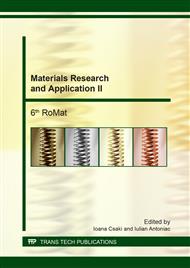p.3
p.9
p.15
p.20
p.26
p.34
p.39
p.45
p.53
Effect of TIG Welding and Manual Metal Arc Welding on Mechanical Properties of AISI 304 and 316L Austenitic Stainless Steel Sheets
Abstract:
The welding technique used for ASIS 304 and 316L austenitic stainless steel sheets both with a thickness of 3mm is gas tungsten arc welding (TIG) and manual metal arc welding (MMAW). Mechanical properties that were verified include: hardness test and tensile test before welding and after it. The welding process was done on two types of specimens: with a central hole and without hole. We concluded that there was a decrease in the properties of tensile for both specimens with central hole, and 316L had tensile characteristics better than 304 when using the technique TIG. As for 304, it had tensile characteristics better than 316L when using the technique MMAW. We also concluded that the existence of central holes had an influence on the hardness characteristics on both types. The hardness increased in 304 but decreased in 316L. The welding process also showed that there was no influence of MMAW on hardness on both specimens. However it showed that there was no influence of TIG on the hardness for 304, but for 316L values increased.
Info:
Periodical:
Pages:
26-33
Citation:
Online since:
August 2017
Price:
Сopyright:
© 2017 Trans Tech Publications Ltd. All Rights Reserved
Share:
Citation:


